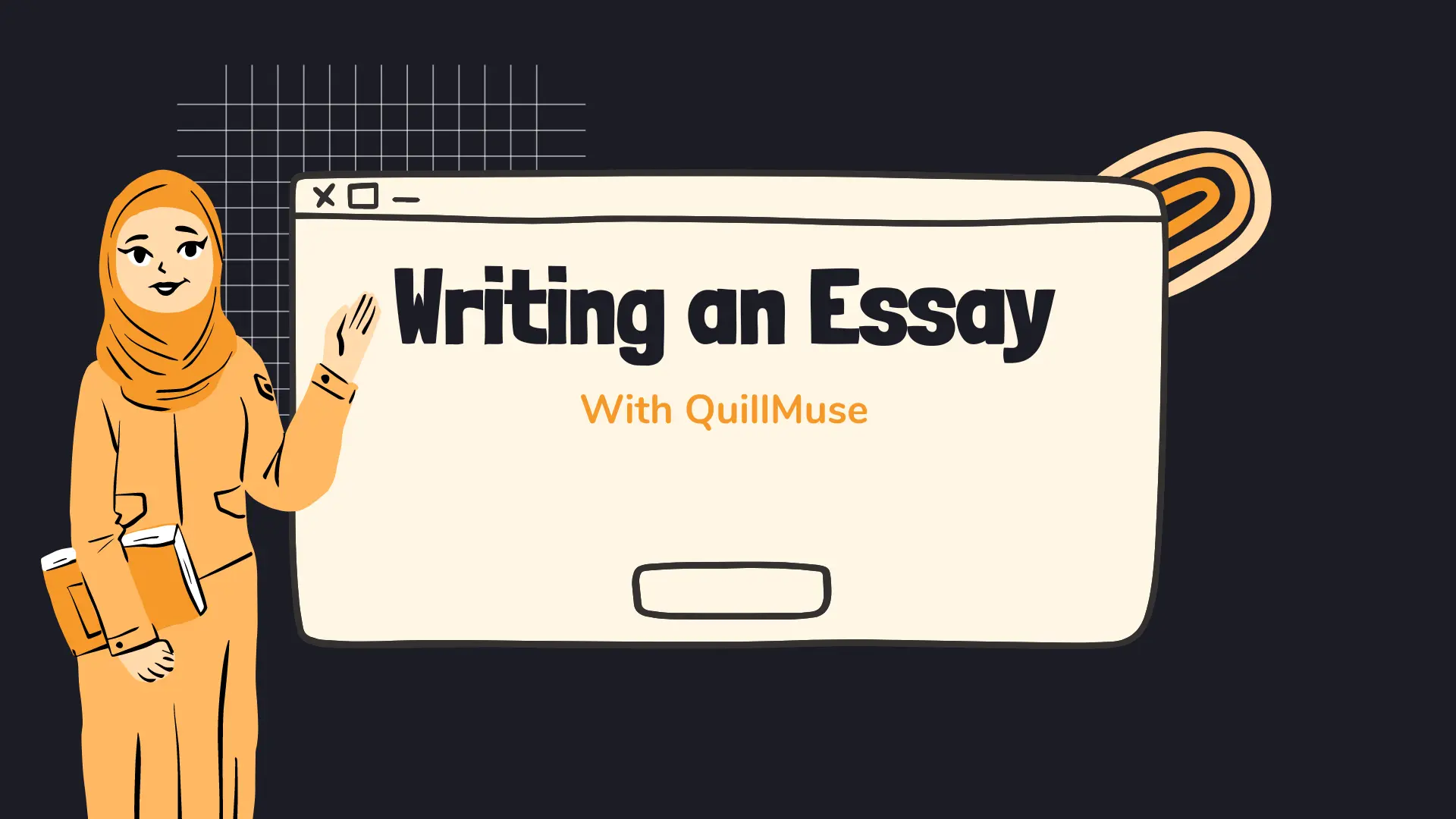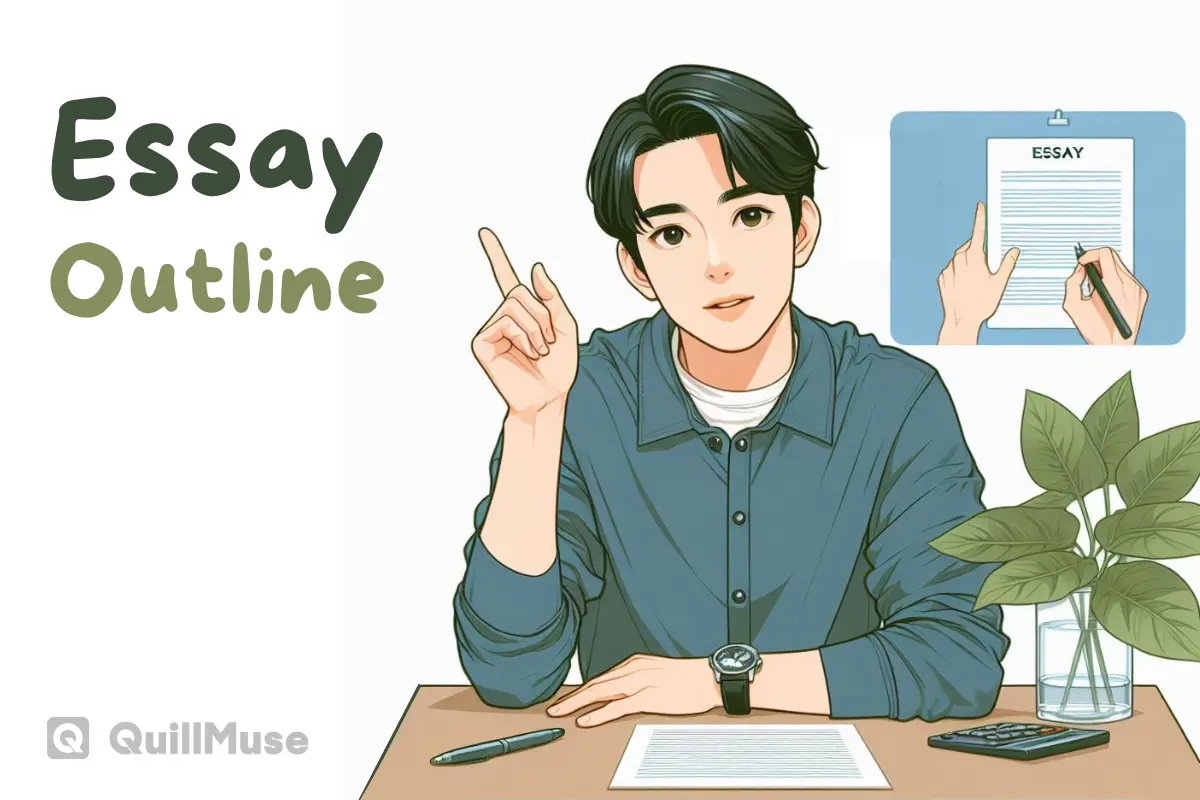How to Write an Essay: A Three-Step Guide with Examples
Learn up your essay writing today! Explore our guide and start writing with confidence.

Rijvi Ahmed
Last updated on Mar 14th, 2024

When you click on affiliate links on QuillMuse.com and make a purchase, you won’t pay a penny more, but we’ll get a small commission—this helps us keep up with publishing valuable content on QuillMuse. Read More.
Table of Contents
Is the essay deadline making you nervous? Do you ever look at the flashing line on your computer screen and want to write something, but just can’t think of anything and feel stuck?
Fear not, a fellow student or maybe even a writer facing a new challenge! This guide is your essay lifeline, ready to transform your essay panic into essay power.
We’ll guide you through everything you need to write a great essay, from figuring out what the question is asking to starting with a grabber of an introduction, building a strong argument, and finishing with a conclusion that leaves the reader feeling good.
This guide will help you learn how to write essays. It will make you feel sure of yourself when you write about any topic. By following this guide, if you are a student you’ll be able to write an essay that your teacher will really like. So, grab a pen, and let’s start that essay together!
Three Main Parts of an Essay
Generally, an essay has three basic parts:
1. Introduction: This is the first paragraph of your essay and it sets the stage for your writing. It should grab the reader’s attention, introduce the topic of your essay, and provide background information. The introduction should also end with a thesis statement, which is a sentence that summarizes the main point of your essay and tells the reader what you will be arguing or explaining.
2. Body Paragraphs: The body paragraphs are where you develop the main points of your essay. Each body paragraph should focus on a single point and may be supported by evidence, such as facts, statistics, quotes, or examples. A body paragraph typically follows a PEE[1] structure, which stands for Point, Evidence, and Explanation.
- Point: The first sentence of your body paragraph should be a topic sentence that states the main point of the paragraph.
- Evidence: This is where you provide evidence to support your topic sentence. Evidence can come from a variety of sources, such as your textbook, articles, websites, or even your own experiences.
- Explanation: Explain how the evidence you provided supports your topic sentence. How does it help to prove your point?
3. Conclusion: The conclusion is the last paragraph of your essay and it summarizes your main points and leaves the reader with a final thought. The conclusion should restate your thesis statement differently and not introduce new information.
The number of body paragraphs you will need will vary depending on the length and complexity of your essay. However, a good rule of thumb is to have at least three body paragraphs for a five-paragraph essay.
How to Write an Essay: A Three-Step Guide

Ever get assigned an essay and have no idea where to start? Don’t worry, this will break it down into 3 simple steps! Think of an essay as a focused report. You pick a topic, do some research, and explain your ideas with evidence.
There are different types of essays, but in college, most are like arguments. You’re trying to convince the reader of your opinion on a topic.
Here’s how to write an amazing essay in 3 steps:
- Preparation: Pick your topic, gather info, and make a plan.
- Write it: Start with your main idea, add details to support it, and wrap it up with a conclusion.
- Revision: Check your work for writing mistakes and make sure everything flows smoothly.
| Preparation for writing | Writing the essay | Revision |
|---|---|---|
| Read and understand the topic | Write the introduction | Proofread |
| Gather info or find facts and details | Write the main body, managed into paragraphs | Edit |
| Write a main point | Write the conclusion | Revise your thesis |
| Create an essay outline | Use a plagiarism checker |
1. Preparation for Writing an Essay
Make sure you know exactly what you want to say and how you’re going to convey it before you start writing. To make sure you’re ready, there are a few essential actions you may take:
You’re absolutely right! Those are the key steps in preparing for an essay. To get you started, here’s a breakdown of each step of preparation for writing an essay:
1. Read and Understand the Topic:
- This is crucial. Make sure you grasp exactly what the essay prompt is asking. Is it analyzing something, arguing a point, or comparing and contrasting?
- Underline key terms and identify the type of essay required.
2. Gather Information or Find Facts and Details:
- Brainstorm ideas related to the topic. What do you already know?
- Research if needed. Look for credible sources like books, articles, or websites (make sure they’re reputable!). Take notes and keep track of where your information comes from (citations are important!).
3. Write a Main Point (Thesis Statement):
- This is the central argument of your essay. It’s a single sentence that summarizes your entire point of view.
- A good thesis statement is clear, concise, and debatable (it allows for discussion).
4. Create an Essay Outline:
- This is your roadmap for writing. It organizes your thoughts and ensures a logical flow.
- An outline typically includes an introduction paragraph, body paragraphs with topic sentences and supporting evidence, and a conclusion paragraph.
By following these preparation steps, you’ll be well on your way to writing a strong and well-structured essay. Remember, the more prepared you are, the easier the writing process becomes!
2. Writing Process of Essay
Writing an essay can be a rewarding journey of exploring ideas and expressing yourself. Let’s break down the process into clear steps, following the introduction, body paragraphs, and conclusion:
1. Introduction
- Hook: Grab your reader’s attention with a thought-provoking statement, an interesting statistic, or a relevant anecdote.
- Background Information: Briefly introduce the topic and provide context for your essay.
- Thesis Statement: Clearly state your main argument or central point. This is the roadmap for your entire essay.
Here’s an Example:
Hook: Imagine a world where social media didn’t exist.
Background Information: Social media platforms have become an undeniable force in our lives, shaping how we connect, consume information, and even perceive ourselves.
Thesis Statement: While social media offers undeniable benefits, its constant presence can have detrimental effects on mental health, particularly for teenagers.
2. Body Paragraphs
- Structure: Each paragraph should focus on a single point that supports your thesis statement.
- Topic Sentence: Start each paragraph with a clear sentence that introduces the main idea and connects back to your thesis.
- Evidence: Support your topic sentence with strong evidence like facts, statistics, quotes from credible sources, or relevant examples. Ensure the evidence directly relates to your point.
- Analysis: Don’t just present evidence; explain how it connects to your argument. Why is this evidence important? How does it support your main point?
- Transition Sentences: (Optional, but helpful) Use transitions between paragraphs to ensure a smooth flow of ideas.
Example Body Paragraph:
Topic Sentence: The constant comparison game fueled by social media can lead to feelings of inadequacy and low self-esteem.
Evidence: A study published by the National Institute of Mental Health found that teenagers who spend more than two hours a day on social media are more likely to experience symptoms of depression and anxiety.
Analysis: This highlights how exposure to carefully curated online lives can create unrealistic expectations and a distorted view of reality, leading to negative self-perception. Teenagers might constantly compare their everyday experiences to the seemingly perfect online personas they see, neglecting their own strengths and accomplishments.
3. Conclusion
- Summarize: Briefly restate your main points and key arguments.
- Restate Thesis: Reiterate your thesis in a new way, emphasizing its importance.
- Closing Statement: Leave a lasting impression with a thought-provoking final sentence that reinforces your argument or offers a call to action.
Example of Conclusion:
In conclusion, while social media offers undeniable benefits for communication and connection, its pervasive influence can have detrimental effects on mental health, particularly for teenagers. Constant exposure to unrealistic portrayals and the pressure to maintain a perfect online persona can fuel feelings of inadequacy and anxiety. It’s crucial to promote healthy online habits and encourage teenagers to focus on real-world connections and self-acceptance.
By following these steps and using the provided examples, you can write a well-structured essay that effectively conveys your ideas and leaves a strong impression on your reader. Remember, practice and revision are key!
3. Revision
Revision is a crucial step in the essay writing process that goes beyond just fixing typos and grammar. It’s about taking a critical look at your work and strengthening it in all aspects. Here’s how the points you mentioned fit into the revision process:
Revise Your Thesis
This isn’t about rewriting your thesis statement entirely, but rather evaluating it. Does it accurately reflect the main argument of your essay? Is it clear and concise? Revision allows you to ensure your thesis effectively guides the reader and ties everything together.
Use a Plagiarism Checker
While not strictly part of revision itself, plagiarism checkers are valuable writing tools. Use them during revision to identify any unintentional plagiarism. This could be due to paraphrasing too closely or forgetting to properly cite sources.
Edit
Editing focuses on the mechanics of your writing. This is where you address typos, grammatical errors, sentence structure, and word choice. It’s about making your writing clear, concise, and polished.
Proofread
Proofreading is the final step in the revision. Here, you meticulously comb through your essay for any remaining writing errors – typos, punctuation mistakes, formatting inconsistencies. Think of it as a final inspection to catch any minor blemishes that editing might have missed.
The Revision Process
Imagine revision as a multi-layered approach. You start with the big picture (thesis) and plagiarism check, then move on to the flow and clarity of your writing (editing), and finally, ensure everything is polished and error-free (proofreading). By tackling revision in this order, you can ensure your essay is strong, clear, and free of major issues.
Essay Checklist
- Did I fully understand what the essay question was asking?
- Did I find enough information to support my essay?
- Is my main argument clear and focused?
- Is my essay well-organized with an introduction, body, and conclusion?
- Does my introduction grab the reader’s attention and state my thesis?
- Do my paragraphs have one main idea each, supported by evidence?
- Did I explain how my evidence supports my argument?
- Did I address opposing viewpoints and respond to them?
- Does my conclusion summarize my main points and restate my thesis?
- Have I checked for errors in grammar, punctuation, and spelling?
- Did I get feedback from others to improve my essay?
FAQs: How to Write an Essay
What is an essay?
An essay is a piece of writing that presents a central argument or idea and develops it with evidence and analysis.
What are the different types of essays?
There are many types of essays, but some common ones include argumentative, persuasive, narrative, expository, and compare-and-contrast essays.
How long should my essay be?
The length of your essay will depend on the specific assignment. However, essays typically range from a few paragraphs to several pages.
How do I choose a topic?
Pick something you’re interested in or that resonates with the prompt. Consider the essay type and what kind of argument you can build.
Do I need to do research?
It depends on the essay type and your instructor’s requirements. However, research can strengthen your arguments and add depth to your writing.
How do I conclude my essay?
Briefly summarize your main points and restate your thesis in a new way. You can also leave the reader with a final thought or question.
How can I improve my essay?
Proofread for grammar errors, typos, and clarity. Revise for logical flow, strong sentence structure, and proper citation formatting (if required).
How we've reviewed this article
Our content is thoroughly researched and fact-checked using reputable sources. While we aim for precision, we encourage independent verification for complete confidence.
1. What is Point, Evidence, Explain? https://www.twinkl.com/teaching-wiki/point-evidence-explain
We keep our articles up-to-date regularly to ensure accuracy and relevance as new information becomes available.
- Current Version
- Mar 14th, 2024
- Mar 9th, 2024


